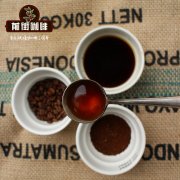How to distinguish between bourbon coffee tree and Brazilian bourbon coffee is not boring.

Professional coffee knowledge exchange more coffee bean information please follow the coffee workshop (Wechat official account cafe_style)
Introduction of Qianjie-bourbon varieties
Arabica (Arabica) coffee beans, first grown in Ethiopia. In the 6th-9th century AD, the raw material of coffee beans as a drink was brought to Yemen, but at that time it was only seed transportation. It was not until 1699 that the Dutch East India Company successfully planted the seeds shipped to the Indonesian island of Java. The coffee trees grown from these coffee seeds were cultivated in 1706 from Java to the botanical garden in Amsterdam. Then, in 1713, the seedlings of these seeds were given to Louis XIV of France. This is the origin of Central and South American coffee.
Around 1720, a French officer named Klee captured coffee saplings from the botanical gardens in Paris and successfully cultivated the coffee saplings on the island of Matinique where he had gone through the hardships of navigation. Since then, coffee trees have spread widely in countries in the Caribbean and even in Central and South America. The variety of coffee beans spread in this way is Typica coffee beans.
It is said that another route of transmission of Arabica coffee was brought by the French from Java to Bourbon (now Reunion) in 1717, where the Arabica species had genetic mutations. The mutated seeds were transplanted to the British colonies of Africa (now Kenya and Tanzania) and then to Central and South America. The variety that has been widely spread through this path is the ancient bourbon coffee beans.
The bourbon tree is the same height and shape as the tin truck, but it is thicker and has more side branches. It was found that the trunk and branches were relatively thicker, so the bourbon tree was stronger and more flexible than the tin card. Between the branches, the shorter distance between the branches and the higher density also means that the yield of bourbon is 30% higher than that of tin trucks.
The leaves of the bourbon tree are wider than tin cards, with rugged leaves and wavy edges. The newly grown leaves are usually green, but the tips are sometimes copper. The fruit is round and can be red, orange or yellow when ripe, but there are no different colors on the same tree.
The flavor of Central and South American beans: generally speaking, the flavor is relatively regular. The Brazilian coffee is mellow and full-bodied, while the Costa Rican coffee is gentle and supple, with a blend of sour, sweet and chocolate aromas. Taste is to smell the dry fragrance, wet fragrance, the feeling in the mouth, the lasting and sweet aftertaste.
Knowledge: iron pickup and bourbon, the two ancient varieties, have multiplied for three hundred years in different soil and water in the new world, creating thousands of varieties and hybrids.
In short: Qianjie is a coffee research hall, happy to share the knowledge about coffee with you, we share unreservedly just to make more friends fall in love with coffee, and there will be three low-discount coffee activities every month. The reason is that Qianjie wants to make more friends drink the best coffee at the lowest price, which has been Qianjie's tenet for 6 years!
END
Important Notice :
前街咖啡 FrontStreet Coffee has moved to new addredd:
FrontStreet Coffee Address: 315,Donghua East Road,GuangZhou
Tel:020 38364473
- Prev

What are the characteristics of bourbon coffee trees? yellow bourbon coffee variety is the treasure of Brazil.
Professional coffee knowledge exchange more coffee bean information please follow the coffee workshop (Wechat official account cafe_style) front street-bourbon variety introduction there are hundreds of varieties of coffee beans, Arabica accounts for about 70% of the world coffee production. Although Arabika is more vulnerable to diseases and insect pests than Robusta, their flavor and aroma are more attractive to most consumers. Producer selection
- Next

The bourbon system represents what kind of coffee beans bourbon coffee beans lead a bumpy life.
Professional coffee knowledge exchange more coffee bean information please follow Coffee Workshop (Wechat official account cafe_style) Front Street-Bourbon varieties introduction in the history of coffee breeding, one was introduced from Yemen to R é union in 1715, bourbon is the first variety planted in R é union on this line. The place was later occupied by France, and it was the bourbon of France at that time.
Related
- Beginners will see the "Coffee pull flower" guide!
- What is the difference between ice blog purified milk and ordinary milk coffee?
- Why is the Philippines the largest producer of crops in Liberia?
- For coffee extraction, should the fine powder be retained?
- How does extracted espresso fill pressed powder? How much strength does it take to press the powder?
- How to make jasmine cold extract coffee? Is the jasmine + latte good?
- Will this little toy really make the coffee taste better? How does Lily Drip affect coffee extraction?
- Will the action of slapping the filter cup also affect coffee extraction?
- What's the difference between powder-to-water ratio and powder-to-liquid ratio?
- What is the Ethiopian local species? What does it have to do with Heirloom native species?

